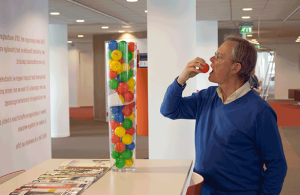 More and more Business Model You community members seek to align individual actions with group goals — by adopting business modeling techniques in teams, workgroups, divisions, and even across the enterprise. Here’s how one midsized enterprise, which we’ll call Ideate, is doing it.
More and more Business Model You community members seek to align individual actions with group goals — by adopting business modeling techniques in teams, workgroups, divisions, and even across the enterprise. Here’s how one midsized enterprise, which we’ll call Ideate, is doing it.
Ideate is a 500-person consultancy that has wholly adopted business model thinking. When we stepped into its gorgeous five-story headquarters on a recent visit, we were greeted by a giant business model Canvas spanning the entryway.
Dennis, our host, explained that Ideate makes its business model clear to everyone: customers, employees, and new graduates aspiring to a career with the company.
For those new graduates, Ideation uses a clever and unusual process that combines recruiting and “onboarding” (new employee socialization).
First, it advertises “career fairs” at leading business and law schools, promising participants on-the-spot interview opportunities with Ideate consultants.
Ideate’s managing director opens each fair with a presentation of the company’s business model, giving participants insight into the sectors and customer segments it serves. Next, an Ideate consultant delivers a brief personal business modeling workshop.
 Here’s where the magic happens: As the final workshop exercise, Ideate asks participants to draw personal business models depicting how they propose to create and deliver value as individual employees within the company.
Here’s where the magic happens: As the final workshop exercise, Ideate asks participants to draw personal business models depicting how they propose to create and deliver value as individual employees within the company.
Following this exercise, participants interview immediately with Ideate recruiters. These interviews focus on 1) the extent to which participants have grasped Ideate‘s organizational model, 2) the thought behind/potential underlying the Value they propose to provide to Ideate and its customers, and 3) how well their personal business models are aligned with Ideate‘s organizational model.
“This approach is extraordinarily effective in identifying high-potential recruits,” says Dennis. “Participants self-identify in terms of ‘getting’ what Ideate does — and the successful ones come close to writing their own job descriptions.”
Candidates who shine during the career fair are invited to return for additional interviews. And according to Dennis, most of those hired start work using the personal business models they first diagrammed at the career fair. Employees hired under the personal business modeling approach score higher in engagement, satisfaction, and retention than those hired under the previous, more traditional approach, says Dennis.
 This process works exceptionally well at Ideate, perhaps because each resident consultant is essentially a one-person “business” who assumes profit and loss responsibility for each client engagement undertaken. Still, Ideate’s approach should be adaptable to many other enterprises.
This process works exceptionally well at Ideate, perhaps because each resident consultant is essentially a one-person “business” who assumes profit and loss responsibility for each client engagement undertaken. Still, Ideate’s approach should be adaptable to many other enterprises.
What happens next at Ideate is even more intriguing. But that’s another post for another time.
For today, here are key learnings:
• Recent graduates seeking work should understand business modeling
• Tasking aspiring employees with aligning personal and enterprise models efficiently combines recruiting and onboarding
• Personal-enterprise model alignment boosts employee engagement, satisfaction, and retention



